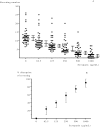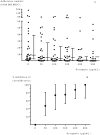Effects of sevuparin on rosette formation and cytoadherence of Plasmodium falciparum infected erythrocytes
- PMID: 28249043
- PMCID: PMC5332063
- DOI: 10.1371/journal.pone.0172718
Effects of sevuparin on rosette formation and cytoadherence of Plasmodium falciparum infected erythrocytes
Abstract
In severe falciparum malaria cytoadherence of parasitised red blood cells (PRBCs) to vascular endothelium (causing sequestration) and to uninfected red cells (causing rosette formation) contribute to microcirculatory flow obstruction in vital organs. Heparin can reverse the underlying ligand-receptor interactions, but may increase the bleeding risks. As a heparin-derived polysaccharide, sevuparin has been designed to retain anti-adhesive properties, while the antithrombin-binding domains have been eliminated, substantially diminishing its anticoagulant activity. Sevuparin has been evaluated recently in patients with uncomplicated falciparum malaria, and is currently investigated in a clinical trial for sickle cell disease. The effects of sevuparin on rosette formation and cytoadherence of Plasmodium falciparum isolates from Thailand were investigated. Trophozoite stages of P. falciparum-infected RBCs (Pf-iRBCs) were cultured from 49 patients with malaria. Pf-iRBCs were treated with sevuparin at 37°C and assessed in rosetting and in cytoadhesion assays with human dermal microvascular endothelial cells (HDMECs) under static and flow conditions. The proportion of Pf-iRBCs forming rosettes ranged from 6.5% to 26.0% (median = 12.2%). Rosetting was dose dependently disrupted by sevuparin (50% disruption by 250 μg/mL). Overall 57% of P. falciparum isolates bound to HDMECs under static conditions; median (interquartile range) Pf-iRBC binding was 8.5 (3.0-38.0) Pf-iRBCs/1000 HDMECs. Sevuparin in concentrations ≥ 100 μg/mL inhibited cytoadherence. Sevuparin disrupts P. falciparum rosette formation in a dose dependent manner and inhibits cytoadherence to endothelial cells. The data support assessment of sevuparin as an adjunctive treatment to the standard therapy in severe falciparum malaria.
Conflict of interest statement
Figures




Similar articles
-
Erythrocyte rosetting in Plasmodium falciparum malaria--with special reference to the pathogenesis of cerebral malaria.Scand J Infect Dis Suppl. 1993;86:1-79. Scand J Infect Dis Suppl. 1993. PMID: 8493454
-
Low anticoagulant heparin disrupts Plasmodium falciparum rosettes in fresh clinical isolates.Am J Trop Med Hyg. 2011 Mar;84(3):390-6. doi: 10.4269/ajtmh.2011.10-0256. Am J Trop Med Hyg. 2011. PMID: 21363975 Free PMC article.
-
Rosetting Plasmodium falciparum-infected erythrocytes bind to human brain microvascular endothelial cells in vitro, demonstrating a dual adhesion phenotype mediated by distinct P. falciparum erythrocyte membrane protein 1 domains.Infect Immun. 2014 Mar;82(3):949-59. doi: 10.1128/IAI.01233-13. Epub 2013 Dec 16. Infect Immun. 2014. PMID: 24343658 Free PMC article.
-
Molecular mechanisms and biological importance of Plasmodium falciparum erythrocyte rosetting.Mem Inst Oswaldo Cruz. 1992;87 Suppl 3:323-9. doi: 10.1590/s0074-02761992000700054. Mem Inst Oswaldo Cruz. 1992. PMID: 1285315 Review.
-
Clinical and molecular aspects of severe malaria.An Acad Bras Cienc. 2005 Sep;77(3):455-75. doi: 10.1590/s0001-37652005000300008. Epub 2005 Aug 24. An Acad Bras Cienc. 2005. PMID: 16127552 Review.
Cited by
-
Heparin, Heparan Sulphate and Sepsis: Potential New Options for Treatment.Pharmaceuticals (Basel). 2023 Feb 10;16(2):271. doi: 10.3390/ph16020271. Pharmaceuticals (Basel). 2023. PMID: 37259415 Free PMC article. Review.
-
A semi-synthetic glycosaminoglycan analogue inhibits and reverses Plasmodium falciparum cytoadherence.PLoS One. 2017 Oct 18;12(10):e0186276. doi: 10.1371/journal.pone.0186276. eCollection 2017. PLoS One. 2017. PMID: 29045442 Free PMC article.
-
Plasma Plasmodium falciparum Histidine-rich Protein 2 Concentrations in Children With Malaria Infections of Differing Severity in Kilifi, Kenya.Clin Infect Dis. 2021 Oct 5;73(7):e2415-e2423. doi: 10.1093/cid/ciaa1141. Clin Infect Dis. 2021. PMID: 32772115 Free PMC article.
-
SEVUparin as a potential Adjunctive Treatment in children with severe malaria: A phase I trial safety and dose finding trial (SEVUSMAART).Wellcome Open Res. 2024 Aug 12;8:484. doi: 10.12688/wellcomeopenres.20111.2. eCollection 2023. Wellcome Open Res. 2024. PMID: 39219856 Free PMC article.
-
Temperature Dependence of Plasmodium falciparum Erythrocytic Stage Development.Am J Trop Med Hyg. 2019 May;100(5):1191-1195. doi: 10.4269/ajtmh.18-0894. Am J Trop Med Hyg. 2019. PMID: 30938284 Free PMC article.
References
-
- WHO. World malaria report 2014. [cited 2015 Nov 20]. http://www.who.int/malaria/media/world_malaria_report_2014/en/.
-
- Pongponratn E, Riganti M, Harinasuta T, Bunnag D. Electron microscopy of the human brain in cerebral malaria. Southeast Asian J Trop Med Public Health 1985;16(2):219–27. - PubMed
MeSH terms
Substances
LinkOut - more resources
Full Text Sources
Other Literature Sources
Medical
Research Materials

